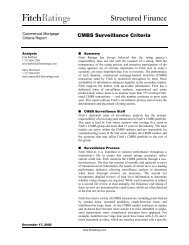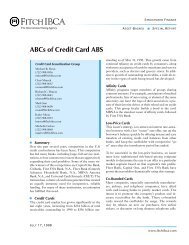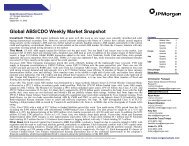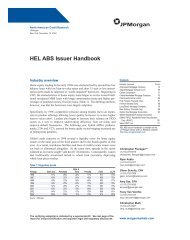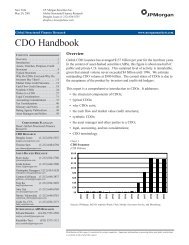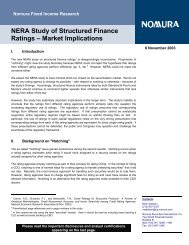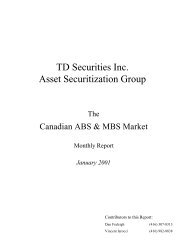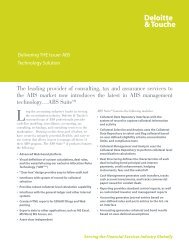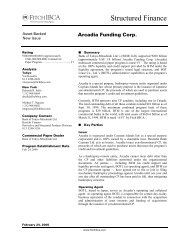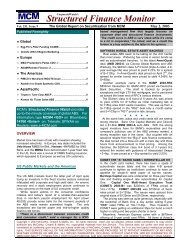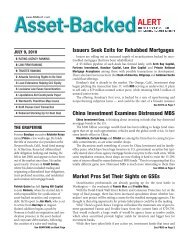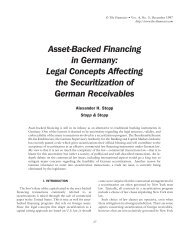Securitization Glossary - Securitization.Net
Securitization Glossary - Securitization.Net
Securitization Glossary - Securitization.Net
Create successful ePaper yourself
Turn your PDF publications into a flip-book with our unique Google optimized e-Paper software.
Nomura Fixed Income Research<br />
case of IO MBS, the notional balance might be the aggregate<br />
balance of all loans in the underlying mortgage pool or it might<br />
be the aggregate balance of a specified portion of the loans<br />
(e.g., those with interest rates above a certain level).<br />
option adjusted spread; OAS – a class of quantitative methods<br />
for assessing the relative value of securities that contain<br />
embedded options. OAS analysis is often applied to residential<br />
MBS because of their embedded short option positions (i.e., the<br />
borrowers' options to prepay their loans). OAS models attempt<br />
to estimate the value of securities by projecting future cash<br />
flows under a variety of interest rate scenarios. A typical OAS<br />
model uses an "interest rate process" to generate multiple<br />
hypothetical paths of future interest rates. For each such path,<br />
the OAS model uses a "prepayment model" to estimate the level<br />
of mortgage loan prepayments in each future month. The<br />
prepayment model produces a hypothetical cash flow<br />
corresponding to each scenario. The OAS model calculates the<br />
fixed spread over benchmark interest rates at which the<br />
discounted value of the modeled cash flows equals the actual<br />
market price of the security.<br />
originator – a lender who originally supplies funds to make a<br />
loan. In the residential mortgage sector originators sometimes<br />
sell their loans to other companies ("conduits" or "aggregators")<br />
that pool them in securitizations.<br />
over-collateralization – a form of credit enhancement where the<br />
principal balance of securitized assets exceeds the balance of<br />
securities issued. For example, if $20 of securities are backed<br />
by $30 of assets, there is $10 of overcollateralization protecting<br />
the $20 of securities. The level of overcollateralization is<br />
described as a percentage of the amount of securities. If $20 of<br />
securities is backed by $30 of assets, there is 50% overcollateralization.<br />
After all the securities are retired, the<br />
overcollateralization assets belong to the holder of the residual<br />
interest in the deal. Overcollateralization is similar to<br />
subordination. Subordination refers to credit enhancement in<br />
the form of subordinated securities. For example, if $20 of<br />
senior securities and $10 of subordinate securities are backed<br />
by $30 of assets, the $20 of senior securities have $10 of<br />
protection just as they did in the prior example. However, the<br />
level of subordination is described as a percentage of the<br />
amount of assets. Thus, in the latter example, the $20 of senior<br />
securities have protection of 33⅓% subordination (i.e., $10<br />
divided by $30).<br />
owner trust – a type of SPE that can issue pay-through securities<br />
(i.e., securities that feature time tranching). Owner trusts have<br />
been replaced by REMICs in the context of mortgage<br />
securitizations. However, owner trusts still are used in<br />
securitizations of non-mortgage assets, such as auto loans.<br />
pass-through – a security that provides for the distribution of<br />
collections or proceeds from specific underlying assets to<br />
investors. The collections or proceeds are said to be "passed<br />
through" to the investors. Basic MBS (i.e., not CMOs) generally<br />
are described as pass-throughs because monthly distributions<br />
to investors exactly reflect collections on the underlying<br />
mortgage pool, less the servicing fee. Pass-through securities<br />
represent ownership interests in the underlying assets. Passthrough<br />
securities typically are issued by "grantor trust" SPEs.<br />
Pass-through structures can provide for the creation of distinct<br />
senior and subordinate interests for the disproportionate<br />
allocation of credit risk. However, pass-through structures<br />
ールのローン 残 高 総 額 、あるいは、 一 部 ローン( 例 えばモーゲージ<br />
金 利 が 一 定 水 準 以 上 のものなど)の 残 高 総 額 などとされる。<br />
オプション 調 整 後 スプレッド; OAS - オプションを 内 包 する 債 券 の<br />
レラティブ・バリューを 測 る 数 量 的 手 法 。OAS 分 析 は、 内 包 オプショ<br />
ンがショートになっている( 債 務 者 がローンを 繰 上 償 還 することが 許<br />
されているため) 住 宅 用 MBS の 投 資 分 析 に 使 用 されることが 多 い。<br />
OAS モデルでは、 様 々な 金 利 環 境 における 将 来 キャッシュフローを<br />
予 想 することにより 証 券 価 値 を 予 想 する。 典 型 的 な OAS モデルで<br />
はまず、「 金 利 プロセス」を 用 いて 複 数 の 金 利 パスを 想 定 する。 次<br />
に、 特 定 の「 期 限 前 返 済 モデル」に 基 づいて、 各 パス 毎 に 予 想 される<br />
毎 月 の 期 限 前 返 済 を 計 算 し、 債 券 の 将 来 キャッシュフローを 予 想 す<br />
る。OAS モデルでは、ベンチマーク 金 利 に 加 算 すると、キャッシュフ<br />
ローの 割 引 現 在 価 値 が 実 際 の 市 場 価 格 に 一 致 するような 一 定 のス<br />
プレッドを 算 出 する。<br />
原 債 権 者 ; オリジネーター - ローンの 貸 出 を 行 なう 貸 し 手 のこと。<br />
米 国 住 宅 用 モーゲージ 市 場 では、オリジネーターから「コンデュイッ<br />
ト」や「アグリゲーター」にローンが 売 却 され、 証 券 化 プールに 集 めら<br />
れることが 多 い。<br />
超 過 担 保 - 信 用 補 完 の 一 形 態 で、 証 券 化 資 産 の 元 本 残 高 が 発 行<br />
される 証 券 の 残 高 を 上 回 る 構 造 を 指 す。 例 えば、30 ドルの 資 産 を 裏<br />
付 けとして 20 ドルの 証 券 を 発 行 する 場 合 、 超 過 担 保 は 10 ドルとな<br />
り、これが 20 ドルの 証 券 を 保 護 している。この 場 合 、 超 過 担 保 の 水<br />
準 は 発 行 証 券 の 残 高 の 割 合 として 表 現 され、20 ドルの 証 券 に 対 し<br />
裏 付 け 資 産 が 30 ドルであることから、 超 過 担 保 は 50%ということに<br />
なる。 証 券 の 償 還 終 了 後 は、 超 過 担 保 分 は 残 余 権 の 保 有 者 に 帰 属<br />
する。 超 過 担 保 は、 劣 後 債 を 設 定 することにより 信 用 補 完 を 図 るサ<br />
ブオーディネーション( 優 先 劣 後 構 造 )と 類 似 している。30 ドルの 裏<br />
付 資 産 に 対 し 20 ドルの 優 先 債 と 10 ドルの 劣 後 債 を 発 行 する 場 合<br />
は、 超 過 担 保 の 場 合 と 同 様 、20 ドルの 優 先 債 は 10 ドルのプロテク<br />
ションを 伴 っていることになる。 但 し、サブオーディネーションの 水 準<br />
は、 裏 付 資 産 の 割 合 として 表 現 されるため、この 場 合 、20 ドルの 優<br />
先 債 は 33.5%(30 ドルの 資 産 に 対 し 10 ドルの 劣 後 債 )のプロテク<br />
ションを 伴 うことになる。<br />
オーナー・トラスト - SPE の 一 種 で、ペイ・スルー 証 券 ( 時 間 的 償 還<br />
順 位 のついた 証 券 )を 発 行 できる。モーゲージ 証 券 の 分 野 では、オ<br />
ーナー・トラスト 形 態 は REMIC に 取 って 代 わられたが、 自 動 車 ロー<br />
ンなどのモーゲージ 以 外 の 資 産 分 野 の 証 券 化 では 依 然 としてオー<br />
ナー・トラスト SPE が 利 用 されている。<br />
パス・スルー 証 券 - 特 定 の 裏 付 資 産 から 発 生 する 支 払 金 額 を 分 配<br />
する 証 券 の 一 種 で、 資 産 から 生 じる 回 収 金 や 受 取 金 が 投 資 家 へ「パ<br />
ス・スルー」されるもの。 一 般 には、 単 純 な 構 造 の MBS(CMO でな<br />
いもの)をパス・スルーと 呼 び、 裏 付 けとなるモーゲージ・プールから<br />
生 じる 回 収 額 からサービシング 手 数 料 を 差 し 引 いたものがそのまま<br />
投 資 家 に 分 配 される。パス・スルー 証 券 は、 裏 付 けとなる 資 産 プール<br />
に 対 する 所 有 権 を 意 味 し、「グランタ-・トラスト」 形 式 の SPE により<br />
発 行 されるのが 一 般 的 である。パス・スルー 構 造 では、 優 先 債 と 劣<br />
後 債 の 間 で 信 用 リスクを 偏 らせることは 可 能 だが、CMO のような 時<br />
間 的 優 先 順 位 のついた 証 券 は 発 行 できない。 従 って、キャッシュフロ<br />
ーが 複 数 のクラス/トランシェに 複 雑 に 分 配 される 場 合 は、パス・スル<br />
ーとは 呼 ばない。「CMO」 及 び「トランシェ」の 欄 も 参 照 。<br />
(15)



